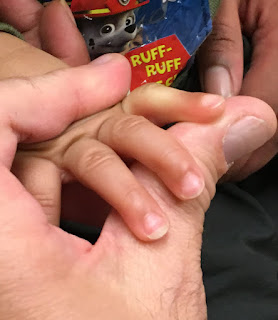I have previously posted several times on camptodactyly, a condition with a stiff, bent finger. Those posts can be viewed HERE. Camptodactyly is relatively common compared to other birth differences of the hand and upper extremity as it can be seen in isolation (i.e., not associated with any other conditions) or in association with cleft hand, ulnar deficiency, arthrogryposis, or other syndromes. It can involve one finger, or several.
Thankfully, many kids with camptodactyly do well with stretching and without surgery as the bent finger position does not affect function. Surgery is reserved for kids with significant bend of the finger that has failed therapy with splinting and interferes with function.
One reader posted about her young child with a flexible camptodactyly. That is, a bent posture of the PIP joint that can be passively straightened (i.e., by mom) but is not able to be straightened actively by the child. In my experience, this is far less common than the more typical, stiff or fixed, camptodactyly. Here are a few photos of a 13 month old child (similar in age to the child mentioned above).
 |
| Flexed position of the PIP joint of the patient’s right index finger. This has the appearance of camptodactyly. |
 |
| In this picture, I am demonstrating that the finger can be fully straightened at the PIP joint- thus not a typical camptodactyly. |
 |
| Live action shot (sorry, a bit blurry) demonstrating that the child cannot straighten the finger on his own. |
This is similar to a clasped thumb, a condition in which the child’s thumb is in the palm and the child cannot straighten it. I have previously blogged about it HERE. As in clasped thumb, we will give the child above time to develop muscle strength to straighten the thumb. In clasped thumb, the strength issue is generally thought to be the EPB muscle (forearm based) whereas in the child above, a weakness of the intrinsic muscles of the hand are to blame. Either way, with time, we hope that the muscles will develop and the straightening power will appear. Our job, while we wait, is to assure that the finger (or thumb) do not get stiff in the the bent position.
My Bio at Washington University
congenitalhand@wudosis.wustl.edu